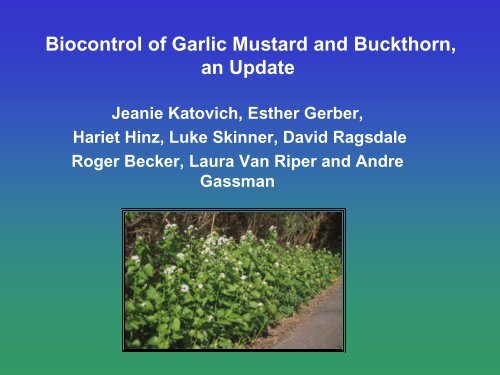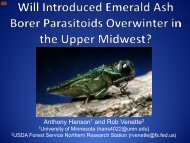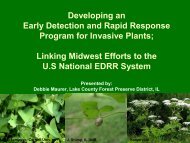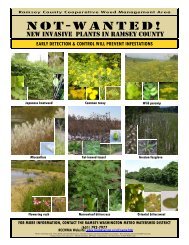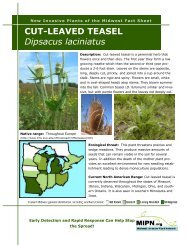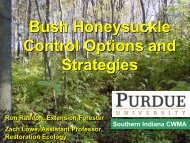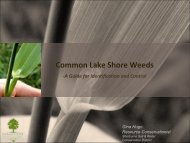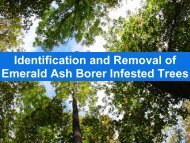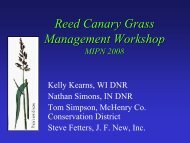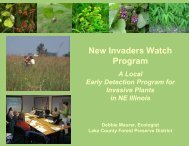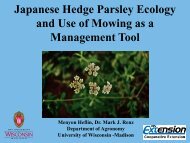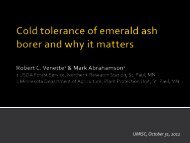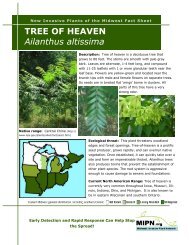Biological Control of Garlic Mustard
Biological Control of Garlic Mustard
Biological Control of Garlic Mustard
- No tags were found...
Create successful ePaper yourself
Turn your PDF publications into a flip-book with our unique Google optimized e-Paper software.
Biocontrol <strong>of</strong> <strong>Garlic</strong> <strong>Mustard</strong> and Buckthorn,an UpdateJeanie Katovich, Esther Gerber,Hariet Hinz, Luke Skinner, David RagsdaleRoger Becker, Laura Van Riper and AndreGassman
Where is garlic mustard a problem?<strong>Garlic</strong> mustardis a problem inthe forest understorywhere it can crowdout more desirablenative speciesSteve Katovich
<strong>Garlic</strong> mustard is also a problem alongforest edges and pathways
<strong>Garlic</strong> mustard distribution by state
<strong>Garlic</strong> mustard is a biennial plantBecker<strong>Garlic</strong> mustard seedlingsemerge early In the spring
<strong>Garlic</strong> mustard grows as a rosette duringthe first year.Steve Katovich
In the spring <strong>of</strong> thesecond season,garlic mustardrosettes bolt andflower.
<strong>Garlic</strong> mustard flowerBecker
<strong>Garlic</strong> mustardplants form seedcapsules in earlysummer
Seeds mature by mid-July
Mature garlic mustard seedsBecker
Potential <strong>Garlic</strong> <strong>Mustard</strong>Biocontrol Insects
Potential Biocontrol Insects for<strong>Garlic</strong> <strong>Mustard</strong>• Ceutorhynchus scrobicollis - crown miner• Ceutorhynchus roberti – stem miner• Ceutorhynchus alliariae – stem miner• Ceutorhynchus constrictus – seed feeder
Ceutorhynchus scrobicollisMcCornack
C. scrobicollis Life CycleSummerAdult AestivationSpringSoil pupationAdult emergenceFallOvipositionWinterOviposition andLarval Development
McCornack
Brian McCornack
Brian McCornack
New Lateral GrowthMain Root CrownLarval Damage
Impact <strong>of</strong> C. scrobicollis ongarlic mustard plants• Increased plant mortality• Reduced above ground biomass• Reduced seed output
Shoot MinersC.alliariae and C. robertiCABI-Bioscience
CABI-Bioscience
Ceutorhynchus scrobicollisC. robertiC. alliariae312..not to forget Ceutorhynchus constrictus..CABI-Bioscience
Host RangeSet <strong>of</strong> plant species on which abiological control insect can feedand develop (McEvoy, 1996)
The ideal biological weedcontrol insect would onlycomplete its life cycle onthe target weed
High Security Containment FacilityUniversity <strong>of</strong> Minnesota, St. Paul, MN
Results <strong>of</strong> Host Range TestingC. scrobicollis• 88 plant species included in nochoicetesting• 51 plant species included in larvaldevelopment tests.
Results <strong>of</strong> Host Range TestsC. scrobicollis• No plant species outside <strong>of</strong> the Brassicaceae family wereattacked by C. scrobicollis.• Within the Brassicaceae family, many plant species wereaccepted for oviposition but did not support larvaldevelopment.• In larval development testing, only one native mustardspecies (Rorippa sinuata) supported the development <strong>of</strong>adults.• When both garlic mustard and Rorippa sinuata wereincluded in single choice testing, only garlic mustard wasattacked. We believe that under field conditions, the risk <strong>of</strong>attack to Rorripa sinuata is very low.
Current Status <strong>of</strong> Host Range TestingProgam• Petition submitted to the Technical AdvisoryGroup for <strong>Biological</strong> <strong>Control</strong> Agents <strong>of</strong> Weeds(TAG).• At TAG reviewers’ request we have included 10additional native mustards, most native tosouthern California, in host range testing.• Additional testing should be completed thiswinter and the TAG petition will be re-submitted.
Buckthorn• Native to Europe• Forms canopies inforest understory• Impacts– Reduced diversity– Ecosystem function– Reduce regeneration<strong>of</strong> tree seedlings– Bird nestingCommon buckthorn(Rhamnus cathartica)Glossy buckthorn(Frangula alnus)(Heneghan et al. 2002; Schmidt and Whelan 1999)
Potential for BuckthornBiocontrol• Research initiated in 2001– CABI Switzerland• Looking for biological control agentsspecific to R. cathartica and F. alnus– 7 Rhamnus species native to the US– 5 Frangula species native to the US• 39 specialized arthropods were identified• 10 were studied further• Host-specificity testing 2003-present
5 high-priority species forfurther researchSpecies Feeding guild Field hostsTrichochermes walkeri(Homoptera, Triozidae)Cacopsylla rhamnicola(Homoptera, Psyllidae)Trioza rhamni(Homoptera, Triozidae)Wachtiella krumbholzi(Diptera; Cecidomyiidae)Lasioptera kosarzewskella(Diptera ; Cecidomyiidae)Sap-sucker/leaf gall inducerSap-suckerSap-sucker /pit-gall inducerSeed-feederSeed-feederR. catharticaR. cathartica;occurrence onF. alnus needsto beconfirmedR. catharticaR. catharticaR. catharticaGassman et al. 2008 report toLCCMR
Trichochermes walkeri(Homoptera, Triozidae)sap-sucker/leaf gall inducerPhotos by A. Gassmann
Phytoplasma found inT. walkeri• Phytoplasma ‘CandidatusPhytoplasma rhamni’(buckthorn witches’ broom)has been detected in twopopulations <strong>of</strong> T. walkeri inSwitzerland.• T. walkeri is the first insecthost record for thisphytoplasma.• Need additional studies• Is the phytoplasma in theUS?Photos <strong>of</strong> other witches broom/ yellows phytoplamsasPhotos from http://en.wikipedia.org/wiki/Phytoplasma
Cacopsylla rhamnicola(Homoptera, Psyllidae)sap-suckerPhotos by A. Gassmann
Gall midgesPhotos by A. Gassmann
Current status <strong>of</strong> biocontrol• Continue to perform host-specificity tests onpotential biocontrol agents• Challenges– Obtaining and growing native Rhamnus and Frangula– Need insects with specificity and high damage levels• Frangula alnus (glossy buckthorn)– Difficulty finding host-specific insect species– Difficult to grow F. alnus at CABI– Work is now focused on Rhamnus cathartica
Current status <strong>of</strong> biocontrol• Rhamnus cathartica (common buckthorn)• Consultation with outside experts will direct work in2010-2012• Continue to assess the feasibility <strong>of</strong> using T. walkeri,C. rhamnicolla, and W. krumbholzi as biologicalcontrol agents for R. cathartica.• Study the causes <strong>of</strong> the high levels <strong>of</strong> seed andseedling mortality <strong>of</strong> R. cathartica observed in Europeas a step toward identifying additional potentialbiological control agents including pathogens.
We would like to thank thefollowing for funding theseprojects:• USDA Forest Service• Minnesota Department <strong>of</strong> NaturalResources• Legislative-Citizen Commission onMinnesota Resources
Letters <strong>of</strong> support for garlic mustardbiocontrol projectPlease contact Jeanie Katovich(katov002@umn.edu)


